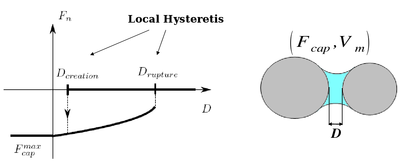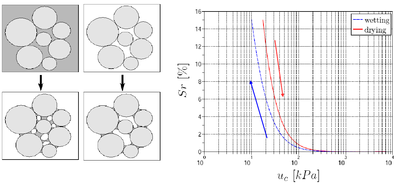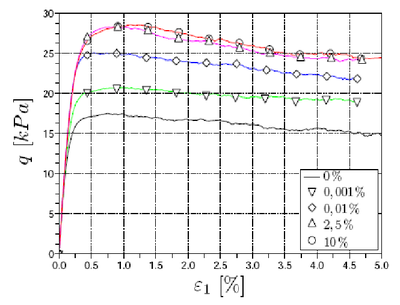CapillaryTriaxialTest
From Yade
Modelling granular materials with capillary forces
Capillary effects are taken into account as a result of capillary bridges between each pair of spherical elements based on the resolution of the Laplace-Young equation (http://en.wikipedia.org/wiki/Young–Laplace_equation). Be careful, the formulation is valid only for pendular menisci involving two grains (the so-called "pendular regime"). At the scale of an assembly, the corresponding degrees of saturation are therefore limited to low values (typically, between 0 and 15%). An algorithm has been developed by B. Chareyre to identify menisci overlaps on each spheres (menisci fusion). Some basic assumptions can be made to reduce capillary forces when menisci overlap (binary->Fcap=0 if at least 1 overlap, linear->Fcap=Fcap/numberOfOverlaps), but this is purely experimental.
The control parameter is the capillary pressure (or suction) Uc, defined as the difference between gas and liquid pressure: Uc = Ugas - Uliquid. Liquid bridges properties (capillary Force Fcap, volume V and extents over interacting grains delta1 and delta2) are computed as a result of the defined Uc and the interacting geometry (spheres radii and interparticular distance).
For more documentation, have a look at:
1 - L. Scholtes, PhD thesis -> http://tel.archives-ouvertes.fr/tel-00363961/en/ (a lot of details but in french)
2- Scholtès, L., Chareyre, B., Nicot, F., Darve, F. (2009), Micromechanics of granular materials with capillary effects. International Journal of Engineering Science (47), pages 64–75. DOI 10.1016/j.ijengsci.2008.07.002
3 - Scholtès, L., Hicher, P.-Y., Chareyre, B., Nicot, F., Darve, F. (2009), On the capillary stress tensor in wet granular materials. International Journal for Numerical and Analytical Methods in Geomechanics (33), pages 1289–1313. DOI 10.1002/nag.767
4 - Scholtès, L., Chareyre, B., Nicot, F., Darve, F. (2009), Discrete modelling of capillary mechanisms in multi-phase granular media. Computer Modeling in Engineering and Sciences (52), pages 297–318. DOI ` <http://dx.doi.org/>`_
To run the simulations, you have to download this [file] and extract the content to your yade/bin folder (where the yade executable is). You should end with 10 text files in /bin. CapillaryLaw will read those files once at startup and use the data to interpolate capillary forces for arbitrary values of suction and particles sizes (assuming a null wetting angle). If yade is started from another path, then the files should be in this path.


